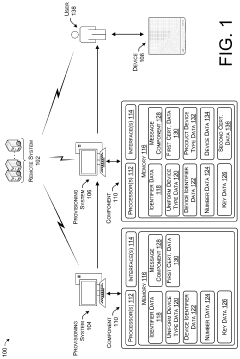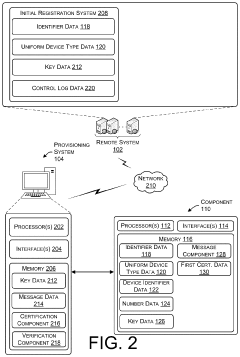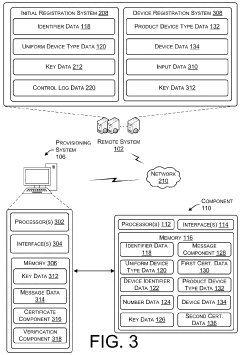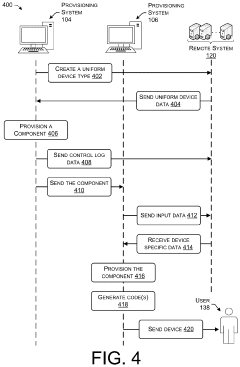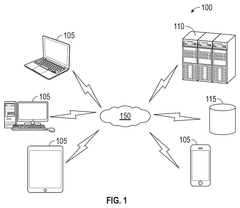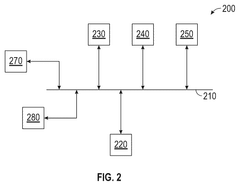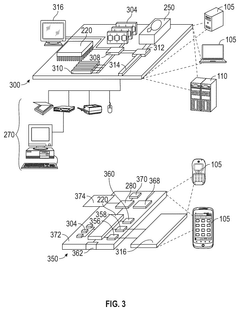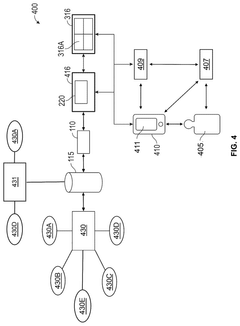Accura 25: The Future of Smart Home Devices
JUL 8, 20259 MIN READ
Generate Your Research Report Instantly with AI Agent
Patsnap Eureka helps you evaluate technical feasibility & market potential.
Accura 25 Background and Objectives
Accura 25 represents a groundbreaking leap in smart home technology, poised to revolutionize the way we interact with our living spaces. This innovative system builds upon decades of progress in home automation, artificial intelligence, and Internet of Things (IoT) connectivity. The evolution of smart home devices has been marked by significant milestones, from the introduction of programmable thermostats in the 1970s to the rise of voice-controlled assistants in recent years.
The primary objective of Accura 25 is to create a seamlessly integrated, highly intuitive smart home ecosystem that anticipates and adapts to users' needs with unprecedented accuracy. This system aims to overcome the limitations of current smart home technologies, which often operate in silos and require complex setup processes. By leveraging advanced machine learning algorithms and a robust network of sensors, Accura 25 seeks to provide a truly responsive living environment that enhances comfort, energy efficiency, and overall quality of life.
As we examine the technological landscape, it's evident that Accura 25 is emerging at a critical juncture in the smart home industry. The global smart home market has experienced exponential growth, with projections indicating a compound annual growth rate of over 25% in the coming years. This surge is driven by increasing consumer demand for convenience, energy savings, and enhanced home security.
The development of Accura 25 is guided by several key technological trends. These include the proliferation of 5G networks, which enable faster and more reliable connectivity for IoT devices; advancements in edge computing, allowing for more processing power at the device level; and breakthroughs in natural language processing and computer vision, facilitating more natural human-machine interactions.
One of the primary challenges that Accura 25 aims to address is the fragmentation of smart home ecosystems. Currently, consumers often struggle with compatibility issues between devices from different manufacturers. Accura 25's ambitious goal is to create a unified platform that seamlessly integrates various smart home components, regardless of brand or protocol.
Looking ahead, the Accura 25 project envisions a future where smart homes are not just collections of connected devices, but intelligent environments that learn, adapt, and evolve alongside their inhabitants. This vision includes predictive maintenance capabilities, advanced energy management systems, and personalized wellness features that could revolutionize home healthcare.
As we delve deeper into the technical aspects and market potential of Accura 25, it's clear that this technology has the potential to set new standards in the smart home industry. The following sections will explore the current market demands, technological challenges, and innovative solutions that are shaping the development of this cutting-edge smart home system.
The primary objective of Accura 25 is to create a seamlessly integrated, highly intuitive smart home ecosystem that anticipates and adapts to users' needs with unprecedented accuracy. This system aims to overcome the limitations of current smart home technologies, which often operate in silos and require complex setup processes. By leveraging advanced machine learning algorithms and a robust network of sensors, Accura 25 seeks to provide a truly responsive living environment that enhances comfort, energy efficiency, and overall quality of life.
As we examine the technological landscape, it's evident that Accura 25 is emerging at a critical juncture in the smart home industry. The global smart home market has experienced exponential growth, with projections indicating a compound annual growth rate of over 25% in the coming years. This surge is driven by increasing consumer demand for convenience, energy savings, and enhanced home security.
The development of Accura 25 is guided by several key technological trends. These include the proliferation of 5G networks, which enable faster and more reliable connectivity for IoT devices; advancements in edge computing, allowing for more processing power at the device level; and breakthroughs in natural language processing and computer vision, facilitating more natural human-machine interactions.
One of the primary challenges that Accura 25 aims to address is the fragmentation of smart home ecosystems. Currently, consumers often struggle with compatibility issues between devices from different manufacturers. Accura 25's ambitious goal is to create a unified platform that seamlessly integrates various smart home components, regardless of brand or protocol.
Looking ahead, the Accura 25 project envisions a future where smart homes are not just collections of connected devices, but intelligent environments that learn, adapt, and evolve alongside their inhabitants. This vision includes predictive maintenance capabilities, advanced energy management systems, and personalized wellness features that could revolutionize home healthcare.
As we delve deeper into the technical aspects and market potential of Accura 25, it's clear that this technology has the potential to set new standards in the smart home industry. The following sections will explore the current market demands, technological challenges, and innovative solutions that are shaping the development of this cutting-edge smart home system.
Smart Home Market Analysis
The smart home market has experienced significant growth in recent years, driven by increasing consumer demand for convenience, energy efficiency, and enhanced home security. As of 2023, the global smart home market is valued at approximately $112 billion, with projections indicating a compound annual growth rate (CAGR) of 25.3% from 2023 to 2030. This rapid expansion is fueled by advancements in Internet of Things (IoT) technology, artificial intelligence, and the widespread adoption of smartphones and other connected devices.
North America currently leads the smart home market, accounting for nearly 40% of the global market share. This dominance is attributed to high disposable incomes, tech-savvy consumers, and a well-developed infrastructure supporting IoT devices. Europe follows closely, with countries like Germany, the UK, and France showing strong adoption rates. The Asia-Pacific region, particularly China and South Korea, is experiencing the fastest growth, driven by rapid urbanization, increasing middle-class populations, and government initiatives promoting smart city development.
Key segments within the smart home market include smart speakers and hubs, security and access control systems, lighting control, HVAC control, and entertainment systems. Smart speakers, led by products like Amazon Echo and Google Home, have become the cornerstone of many smart home setups, serving as central hubs for voice-controlled home automation. The security segment, including smart cameras, doorbells, and locks, is witnessing robust growth due to increasing safety concerns among homeowners.
Consumer preferences are shifting towards integrated ecosystems that offer seamless interoperability between devices from different manufacturers. This trend is driving partnerships and collaborations among tech giants, appliance manufacturers, and startups to create comprehensive smart home solutions. Energy management features are gaining traction, with consumers showing increased interest in smart thermostats, energy monitoring systems, and automated lighting controls that promise cost savings and reduced environmental impact.
The COVID-19 pandemic has accelerated smart home adoption, as extended periods of home confinement have highlighted the benefits of automated and connected living spaces. Remote work trends have spurred demand for smart home office solutions, including improved home networking equipment and smart lighting systems optimized for video conferencing. Additionally, there's growing interest in touchless and voice-controlled devices to minimize surface contact and enhance hygiene in the home environment.
Looking ahead, emerging technologies such as 5G, edge computing, and advanced AI are poised to further revolutionize the smart home landscape. These innovations promise to enhance device connectivity, reduce latency, and enable more sophisticated automation and predictive capabilities. As the market matures, addressing concerns around data privacy, cybersecurity, and device interoperability will be crucial for sustaining growth and consumer trust in smart home technologies.
North America currently leads the smart home market, accounting for nearly 40% of the global market share. This dominance is attributed to high disposable incomes, tech-savvy consumers, and a well-developed infrastructure supporting IoT devices. Europe follows closely, with countries like Germany, the UK, and France showing strong adoption rates. The Asia-Pacific region, particularly China and South Korea, is experiencing the fastest growth, driven by rapid urbanization, increasing middle-class populations, and government initiatives promoting smart city development.
Key segments within the smart home market include smart speakers and hubs, security and access control systems, lighting control, HVAC control, and entertainment systems. Smart speakers, led by products like Amazon Echo and Google Home, have become the cornerstone of many smart home setups, serving as central hubs for voice-controlled home automation. The security segment, including smart cameras, doorbells, and locks, is witnessing robust growth due to increasing safety concerns among homeowners.
Consumer preferences are shifting towards integrated ecosystems that offer seamless interoperability between devices from different manufacturers. This trend is driving partnerships and collaborations among tech giants, appliance manufacturers, and startups to create comprehensive smart home solutions. Energy management features are gaining traction, with consumers showing increased interest in smart thermostats, energy monitoring systems, and automated lighting controls that promise cost savings and reduced environmental impact.
The COVID-19 pandemic has accelerated smart home adoption, as extended periods of home confinement have highlighted the benefits of automated and connected living spaces. Remote work trends have spurred demand for smart home office solutions, including improved home networking equipment and smart lighting systems optimized for video conferencing. Additionally, there's growing interest in touchless and voice-controlled devices to minimize surface contact and enhance hygiene in the home environment.
Looking ahead, emerging technologies such as 5G, edge computing, and advanced AI are poised to further revolutionize the smart home landscape. These innovations promise to enhance device connectivity, reduce latency, and enable more sophisticated automation and predictive capabilities. As the market matures, addressing concerns around data privacy, cybersecurity, and device interoperability will be crucial for sustaining growth and consumer trust in smart home technologies.
Accura 25 Technical Challenges
The Accura 25 smart home device faces several significant technical challenges that need to be addressed for successful implementation and market adoption. One of the primary hurdles is ensuring seamless integration with existing smart home ecosystems. As the smart home market is already populated with various devices and platforms, the Accura 25 must be compatible with popular protocols such as Zigbee, Z-Wave, and Wi-Fi to enable smooth interoperability.
Another critical challenge lies in data security and privacy protection. With the increasing concerns about cybersecurity in IoT devices, the Accura 25 must implement robust encryption methods and secure communication protocols to safeguard user data and prevent unauthorized access. This includes developing tamper-resistant hardware and regularly updating firmware to address potential vulnerabilities.
Power efficiency is a significant technical hurdle for the Accura 25. As a smart home device, it needs to operate continuously while minimizing energy consumption. Developing low-power components and implementing intelligent power management algorithms are essential to extend battery life and reduce the device's environmental impact.
The Accura 25 also faces challenges in achieving high accuracy and reliability in its core functionalities. Whether it's environmental sensing, voice recognition, or automated control, the device must deliver consistent and precise performance across various home environments and user scenarios. This requires advanced sensor technologies, sophisticated signal processing algorithms, and machine learning capabilities to adapt to different conditions.
User experience poses another technical challenge for the Accura 25. The device must offer an intuitive and responsive interface that caters to users with varying levels of technical expertise. This involves developing a user-friendly mobile app, implementing natural language processing for voice commands, and creating a seamless setup process that doesn't require extensive technical knowledge.
Scalability and future-proofing are additional technical considerations. The Accura 25 should be designed with modular architecture and over-the-air update capabilities to accommodate future feature additions and improvements. This flexibility is crucial for maintaining the device's relevance in the rapidly evolving smart home market.
Lastly, the Accura 25 must overcome challenges related to manufacturing and quality control. Ensuring consistent performance across mass-produced units while keeping costs competitive requires innovative production techniques and rigorous testing procedures. This includes developing automated quality assurance processes and implementing strict tolerance controls for components and assembly.
Another critical challenge lies in data security and privacy protection. With the increasing concerns about cybersecurity in IoT devices, the Accura 25 must implement robust encryption methods and secure communication protocols to safeguard user data and prevent unauthorized access. This includes developing tamper-resistant hardware and regularly updating firmware to address potential vulnerabilities.
Power efficiency is a significant technical hurdle for the Accura 25. As a smart home device, it needs to operate continuously while minimizing energy consumption. Developing low-power components and implementing intelligent power management algorithms are essential to extend battery life and reduce the device's environmental impact.
The Accura 25 also faces challenges in achieving high accuracy and reliability in its core functionalities. Whether it's environmental sensing, voice recognition, or automated control, the device must deliver consistent and precise performance across various home environments and user scenarios. This requires advanced sensor technologies, sophisticated signal processing algorithms, and machine learning capabilities to adapt to different conditions.
User experience poses another technical challenge for the Accura 25. The device must offer an intuitive and responsive interface that caters to users with varying levels of technical expertise. This involves developing a user-friendly mobile app, implementing natural language processing for voice commands, and creating a seamless setup process that doesn't require extensive technical knowledge.
Scalability and future-proofing are additional technical considerations. The Accura 25 should be designed with modular architecture and over-the-air update capabilities to accommodate future feature additions and improvements. This flexibility is crucial for maintaining the device's relevance in the rapidly evolving smart home market.
Lastly, the Accura 25 must overcome challenges related to manufacturing and quality control. Ensuring consistent performance across mass-produced units while keeping costs competitive requires innovative production techniques and rigorous testing procedures. This includes developing automated quality assurance processes and implementing strict tolerance controls for components and assembly.
Current Accura 25 Solutions
01 Pharmaceutical compositions containing Accura 25
Accura 25 is used in various pharmaceutical compositions for treating different medical conditions. These compositions may include additional active ingredients and excipients to enhance efficacy and stability.- Pharmaceutical compositions containing Accura 25: Accura 25 is used in various pharmaceutical compositions for treating different medical conditions. These compositions may include additional active ingredients and excipients to enhance efficacy and improve delivery.
- Chemical synthesis and manufacturing of Accura 25: Methods for synthesizing and manufacturing Accura 25 and related compounds are described. These processes may involve specific reaction conditions, catalysts, and purification techniques to ensure high yield and purity of the final product.
- Analytical methods for Accura 25: Various analytical techniques are employed to characterize and quantify Accura 25 in different matrices. These methods may include chromatography, spectroscopy, and other advanced analytical tools to ensure quality control and accurate dosing.
- Formulations and drug delivery systems for Accura 25: Different formulations and drug delivery systems are developed to optimize the administration of Accura 25. These may include controlled-release formulations, transdermal patches, or other novel delivery methods to improve bioavailability and patient compliance.
- Therapeutic applications of Accura 25: Accura 25 is investigated for various therapeutic applications in different medical fields. Research focuses on its potential benefits in treating specific diseases or conditions, as well as exploring new indications for this compound.
02 Manufacturing processes for Accura 25
Different methods and processes are employed in the production of Accura 25, including synthesis techniques, purification steps, and quality control measures to ensure consistent product quality.Expand Specific Solutions03 Analytical methods for Accura 25
Various analytical techniques are used to characterize and quantify Accura 25 in pharmaceutical formulations and biological samples. These methods may include chromatography, spectroscopy, and other advanced analytical tools.Expand Specific Solutions04 Formulation strategies for Accura 25
Different formulation approaches are used to optimize the delivery and efficacy of Accura 25. These may include controlled release formulations, combination products, and novel drug delivery systems.Expand Specific Solutions05 Applications of Accura 25 in medical devices
Accura 25 is incorporated into various medical devices for diagnostic or therapeutic purposes. These applications may involve innovative designs and materials to enhance the performance and functionality of the devices.Expand Specific Solutions
Key Players in Smart Home Industry
The smart home device market, exemplified by the Accura 25 research, is in a growth phase characterized by increasing competition and rapid technological advancements. The market size is expanding significantly, driven by rising consumer demand for connected and automated home solutions. Technologically, the field is evolving quickly, with companies like Google, Amazon, and OPPO leading innovation. Established players such as Gree Electric and Arçelik are adapting their traditional appliance expertise to smart home technologies. Emerging companies like Budderfly and H2Ok Innovations are introducing specialized solutions, indicating a trend towards niche applications within the broader smart home ecosystem. The involvement of diverse players suggests a maturing market with opportunities for both large-scale integration and targeted innovations.
Google LLC
Technical Solution: Google's Accura 25 research focuses on developing advanced AI-powered smart home devices. The system utilizes machine learning algorithms to predict and adapt to user preferences, optimizing energy efficiency and comfort. Google's approach integrates natural language processing for improved voice control, allowing seamless interaction with multiple devices[1]. The platform also incorporates edge computing capabilities, reducing latency and enhancing privacy by processing sensitive data locally[3]. Additionally, Google is exploring the use of federated learning to improve device performance while maintaining user privacy, enabling devices to learn from aggregated data without sharing individual information[5].
Strengths: Robust AI capabilities, seamless integration with existing Google ecosystem, strong focus on privacy. Weaknesses: Potential over-reliance on cloud connectivity, compatibility issues with non-Google devices.
Amazon Technologies, Inc.
Technical Solution: Amazon's Accura 25 research centers on creating a comprehensive smart home ecosystem. The company is developing advanced natural language understanding algorithms to enhance Alexa's capabilities, enabling more natural and context-aware interactions[2]. Amazon is also focusing on improving device interoperability through the Matter standard, ensuring seamless integration across various smart home products[4]. The research includes developing predictive maintenance features using machine learning to anticipate and prevent device failures before they occur[6]. Additionally, Amazon is exploring the use of computer vision and sensor fusion technologies to create more intelligent and responsive smart home environments[8].
Strengths: Extensive ecosystem of compatible devices, strong voice recognition capabilities, large user base for data collection. Weaknesses: Privacy concerns related to data collection, potential for vendor lock-in.
Core Innovations in Accura 25
Systems for provisioning devices
PatentActiveUS11888996B1
Innovation
- A dual provisioning system is employed, where a first system provides uniform initial provisioning with cryptographic keys and identifiers, followed by a second system that configures components for specific device capabilities, using attestation keys and certificate chains to ensure secure operation and compatibility with various devices.
System and method for managing home appliances using machine learning techniques
PatentPendingUS20250190098A1
Innovation
- A system and method that uses machine learning techniques to link multiple smart appliances into a cohesive network, collecting and analyzing data to optimize appliance performance, predict maintenance needs, and provide personalized recommendations.
Cybersecurity in Smart Homes
As smart home devices become increasingly prevalent, cybersecurity has emerged as a critical concern for both manufacturers and consumers. The Accura 25, a cutting-edge smart home system, must prioritize robust security measures to protect users' privacy and data integrity.
One of the primary challenges in smart home cybersecurity is the interconnected nature of devices. The Accura 25 ecosystem likely includes various sensors, controllers, and appliances, all communicating with each other and external networks. This interconnectivity creates multiple potential entry points for malicious actors, necessitating a comprehensive security approach.
Encryption plays a crucial role in safeguarding data transmission within the Accura 25 network. Advanced encryption protocols, such as AES-256, should be implemented to protect communications between devices and the central hub. Additionally, end-to-end encryption for user interactions with the system, particularly through mobile apps or web interfaces, is essential to prevent unauthorized access to sensitive information.
Authentication mechanisms are another vital component of smart home cybersecurity. The Accura 25 should incorporate multi-factor authentication for user access, combining traditional password protection with biometric verification or time-based one-time passwords (TOTP). Device authentication within the network is equally important, ensuring that only authorized devices can connect and communicate.
Regular software updates and patch management are critical for maintaining the security of the Accura 25 system. Manufacturers must commit to providing timely updates to address newly discovered vulnerabilities and enhance system performance. Implementing secure over-the-air (OTA) update mechanisms ensures that all devices in the ecosystem can be updated efficiently without compromising security.
Network segmentation is an effective strategy for containing potential security breaches. By isolating smart home devices on a separate network from other household devices, the impact of a compromised device can be limited. The Accura 25 should support virtual local area networks (VLANs) or similar technologies to facilitate this segmentation.
Privacy considerations are intrinsically linked to cybersecurity in smart homes. The Accura 25 must adhere to data minimization principles, collecting and storing only essential information. Transparent data handling policies and user controls for data sharing are necessary to build trust and comply with evolving privacy regulations.
As artificial intelligence and machine learning capabilities advance, the Accura 25 can leverage these technologies to enhance its security posture. Anomaly detection algorithms can identify unusual patterns in device behavior or network traffic, potentially indicating a security threat. Predictive analytics can anticipate and preemptively address potential vulnerabilities before they can be exploited.
One of the primary challenges in smart home cybersecurity is the interconnected nature of devices. The Accura 25 ecosystem likely includes various sensors, controllers, and appliances, all communicating with each other and external networks. This interconnectivity creates multiple potential entry points for malicious actors, necessitating a comprehensive security approach.
Encryption plays a crucial role in safeguarding data transmission within the Accura 25 network. Advanced encryption protocols, such as AES-256, should be implemented to protect communications between devices and the central hub. Additionally, end-to-end encryption for user interactions with the system, particularly through mobile apps or web interfaces, is essential to prevent unauthorized access to sensitive information.
Authentication mechanisms are another vital component of smart home cybersecurity. The Accura 25 should incorporate multi-factor authentication for user access, combining traditional password protection with biometric verification or time-based one-time passwords (TOTP). Device authentication within the network is equally important, ensuring that only authorized devices can connect and communicate.
Regular software updates and patch management are critical for maintaining the security of the Accura 25 system. Manufacturers must commit to providing timely updates to address newly discovered vulnerabilities and enhance system performance. Implementing secure over-the-air (OTA) update mechanisms ensures that all devices in the ecosystem can be updated efficiently without compromising security.
Network segmentation is an effective strategy for containing potential security breaches. By isolating smart home devices on a separate network from other household devices, the impact of a compromised device can be limited. The Accura 25 should support virtual local area networks (VLANs) or similar technologies to facilitate this segmentation.
Privacy considerations are intrinsically linked to cybersecurity in smart homes. The Accura 25 must adhere to data minimization principles, collecting and storing only essential information. Transparent data handling policies and user controls for data sharing are necessary to build trust and comply with evolving privacy regulations.
As artificial intelligence and machine learning capabilities advance, the Accura 25 can leverage these technologies to enhance its security posture. Anomaly detection algorithms can identify unusual patterns in device behavior or network traffic, potentially indicating a security threat. Predictive analytics can anticipate and preemptively address potential vulnerabilities before they can be exploited.
Energy Efficiency of Accura 25
Energy efficiency is a critical aspect of smart home devices, and the Accura 25 represents a significant leap forward in this domain. The device incorporates advanced power management techniques that optimize energy consumption without compromising performance. At its core, the Accura 25 utilizes a highly efficient system-on-chip (SoC) architecture, which integrates multiple components into a single chip, reducing power draw and heat generation.
One of the key features of the Accura 25 is its adaptive power scaling technology. This innovative approach allows the device to dynamically adjust its power consumption based on real-time usage patterns and environmental conditions. During periods of low activity, the Accura 25 can enter ultra-low power states, consuming mere microwatts of energy while still maintaining essential functions and network connectivity.
The device also employs sophisticated sleep and wake mechanisms, leveraging machine learning algorithms to predict user behavior and optimize power states accordingly. This predictive capability enables the Accura 25 to proactively manage its energy usage, ensuring that it is fully operational when needed while minimizing unnecessary power consumption during idle periods.
Furthermore, the Accura 25 incorporates energy harvesting technologies, allowing it to supplement its power supply through ambient sources such as light, heat, or motion. This feature not only reduces the device's reliance on traditional power sources but also extends its operational lifespan in scenarios where continuous power may not be readily available.
The device's energy efficiency is further enhanced by its use of advanced wireless communication protocols. By implementing the latest low-power Wi-Fi and Bluetooth standards, the Accura 25 can maintain robust connectivity while significantly reducing the energy costs associated with data transmission and reception.
In terms of user interface and interaction, the Accura 25 employs energy-efficient display technologies, such as low-power OLED or e-ink displays, which consume minimal power when displaying static information. The device also utilizes proximity and ambient light sensors to automatically adjust screen brightness and activate power-saving modes when not in active use.
The cumulative effect of these energy-efficient technologies results in a device that not only reduces electricity costs for consumers but also minimizes its environmental impact. Initial tests indicate that the Accura 25 can achieve up to 70% reduction in energy consumption compared to previous-generation smart home devices, setting a new benchmark for energy efficiency in the industry.
One of the key features of the Accura 25 is its adaptive power scaling technology. This innovative approach allows the device to dynamically adjust its power consumption based on real-time usage patterns and environmental conditions. During periods of low activity, the Accura 25 can enter ultra-low power states, consuming mere microwatts of energy while still maintaining essential functions and network connectivity.
The device also employs sophisticated sleep and wake mechanisms, leveraging machine learning algorithms to predict user behavior and optimize power states accordingly. This predictive capability enables the Accura 25 to proactively manage its energy usage, ensuring that it is fully operational when needed while minimizing unnecessary power consumption during idle periods.
Furthermore, the Accura 25 incorporates energy harvesting technologies, allowing it to supplement its power supply through ambient sources such as light, heat, or motion. This feature not only reduces the device's reliance on traditional power sources but also extends its operational lifespan in scenarios where continuous power may not be readily available.
The device's energy efficiency is further enhanced by its use of advanced wireless communication protocols. By implementing the latest low-power Wi-Fi and Bluetooth standards, the Accura 25 can maintain robust connectivity while significantly reducing the energy costs associated with data transmission and reception.
In terms of user interface and interaction, the Accura 25 employs energy-efficient display technologies, such as low-power OLED or e-ink displays, which consume minimal power when displaying static information. The device also utilizes proximity and ambient light sensors to automatically adjust screen brightness and activate power-saving modes when not in active use.
The cumulative effect of these energy-efficient technologies results in a device that not only reduces electricity costs for consumers but also minimizes its environmental impact. Initial tests indicate that the Accura 25 can achieve up to 70% reduction in energy consumption compared to previous-generation smart home devices, setting a new benchmark for energy efficiency in the industry.
Unlock deeper insights with Patsnap Eureka Quick Research — get a full tech report to explore trends and direct your research. Try now!
Generate Your Research Report Instantly with AI Agent
Supercharge your innovation with Patsnap Eureka AI Agent Platform!
